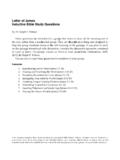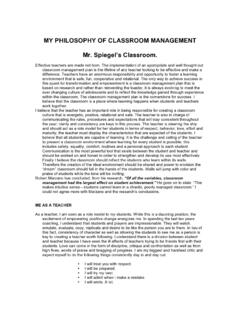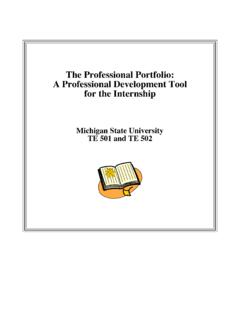Transcription of A Basic Masonic Education Course For Entered Apprentices ...
1 The Grand Lodge of Free & Accepted Masons of Ohio A Basic Masonic Education Course For Entered Apprentices With Questions Prepared by The Committee on Masonic Education and Information of THE GRAND LODGE OF FREE AND ACCEPTED MASONS OF OHIO 2008, Grand Lodge of Ohio 1 THE Entered APPRENTICE This manual does not disclose any of the esoteric portions of the ritual of the Grand Lodge of Ohio. The contents of this manual therefore may be discussed with, and read by, any person interested in acquiring knowledge about Freemasonry. Masonic organizations are invited to reproduce, extract, copy or reprint the contents of this book. 2 TABLE OF CONTENTS GENERAL INTRODUCTION Purpose of this Manual Freemasonry Defined The Purpose of Freemasonry Origin of Freemasonry o Transition from Operative to Speculative o King Solomon s Temple o The Origin of our Ritual o Origin of the First Grand Lodge Grand Lodge Titles The Title Free and Accepted Is Freemasonry a Secret Society?
2 Is Freemasonry a Religion? The Use of Symbolism and Allegory THE Entered APPRENTICE DEGREE Qualifications of a Petitioner The Secret Ballot Preparation for Initiation Duly and Truly Prepared The Hoodwink The Cable-Tow Entering the Lodge The Method of Reception Prayer in Lodge The Practice of Circumambulation Kneeling at the Altar The Obligation The Three Great Lights of Masonry Presentation of the Lambskin Apron Working Tools of an Entered Apprentice The Northeast Corner The Lecture of this Degree The Charge Masonic DECORUM AND ADVANCEMENT The Proficiency Exam The Language of Freemasonry When to rise and when to be seated Subjects not proper for Discussion in Lodge The Worshipful Master The Tyler No Horseplay or Hazing the heart of the Masonic Family The Rights of an Entered Apprentice The Responsibilities of an Entered Apprentice Masonic Glossary: Entered Apprentice Questions for the Entered Apprentice Answers to Questions 3 GENERAL INTRODUCTION PURPOSE OF THIS MANUAL The intent of this manual is basically twofold: first, to provide the new member of Freemasonry with more information about the Fraternity, its structure, practices and symbolism; and secondly, to offer suggestive approaches for further research if one is so inclined.
3 We feel that there is not only a great need for this type of information but also a great desire for it as well. Masonic Education begins with the study of the rituals themselves. After that, the newly made Mason is given references for personal study. For some this is enough, but for others it is not. This manual provides the next logical step for the student of the mysteries of Freemasonry. It is not our purpose here to repeat what is contained within our rituals or in other sources but to stimulate the mind and provoke further research by offering a variety of approaches to consider. FREEMASONRY DEFINED Freemasonry cannot be defined in a few sentences or pat answers. One of the most common definitions is that it is a system of morality, veiled in allegory (or a story) and illustrated by symbols. This is true, but Freemasonry is more than that. While it is certainly a Course of moral instruction that uses both allegories and symbols to teach its lessons, Freemasonry is also an organized society of men, a fraternity.
4 It uses symbols derived from operative stonemasonry and architecture but not exclusively. Much of its symbolism is also taken from Biblical sources, especially the stories surrounding the building of King Solomon s Temple. Great stress is placed upon the development of moral and ethical virtues and the building of character, with Truth being the guiding principle of our lives. Thus, Brotherhood and charity are natural outcomes which further define what we are. In other words, we are using proven methods to enhance the lives and spirits of our members in a tangible way. There are also aspects of Freemasonry that enrich our lives and spirits in an intangible way. This part of Freemasonry is harder to define but is just as real. There is something very profound about Freemasonry. It seems to speak to a hidden part of oneself that responds with a deep reverence and respect.
5 The deeper one takes his studies of the rites and symbols of Freemasonry, the richer his Masonic life becomes. In his poem, "When is a Man a Mason?" the Rev. Joseph Fort Newton captured the essence of what it means to be a Freemason: "When he can look out over the rivers, the hills, and the far horizon with a profound sense of his own littleness in the vast scheme of things, and yet have faith, hope, and courage-which are the root of every virtue. When he knows that down in his heart every man is as noble, as vile, as divine, as diabolic, and as lonely as himself, and seeks to know, to forgive, and to love his fellowman. When he knows how to sympathize with men in their sorrows yea even in their sins-knowing that each man fights a hard fight against many odds. When he has learned how to make friends and how to keep them and above all how to keep friends with himself.
6 When he loves flowers, can hunt birds without a gun, and feels the thrill of an old forgotten joy when he hears the laugh of a little child. When he can be happy and high-minded amid the meaner drudgeries of life. When star-crowned trees and the glint of sunlight on flowing waters subdue him like the thought of one much loved and long dead. When no voice of distress reaches his ears in vain, and no hand seeks his aid without response. 4 When he finds good in every faith that helps any man to lay hold of divine things and sees majestic meanings in life, whatever the name of that faith may be. When he can look into a wayside puddle and see something beyond mud, and into the face of the most forlorn fellow mortal and see something beyond sin. When he knows how to pray, how to love and how to hope. When he has kept faith with himself, with his fellowman, and with his God; in his hands a sword for evil, in his heart a bit of a song-glad to live, but not afraid to die!
7 Such a man has found the only real secret of Freemasonry, and the one which it is trying to give to all the world." THE PURPOSE OF FREEMASONRY What is the purpose of Freemasonry? One of its most Basic purposes is to make good men even better. We try to place emphasis on the individual man by strengthening his character, improving his moral and spiritual outlook, and broadening his mental horizons. We try to impress upon the minds of our members the principles of personal responsibility and morality, encouraging each member to practice in his daily life the lessons taught through symbolic ceremonies in the Lodge. One of the universal doctrines of Freemasonry is the belief in the Brotherhood of Man and the Fatherhood of God . The importance of this belief is established by each Mason as he practices the three principle tenets of Freemasonry: Brotherly Love, Relief and Truth. Freemasonry is also the custodian of a tradition of initiation.
8 It is the duty of every Freemason to preserve and perpetuate this tradition for future ages. This is a heavy responsibility and should give pause to any who would seek to make changes in the body of the Craft, except those with the highest motives and deepest understanding of the principles involved. ORIGIN OF FREEMASONRY TRANSITION FROM OPERATIVE TO SPECULATIVE What is the difference between Operative and Speculative Masonry? Operative refers to the time in our history when Masons actually performed the physical labor of building. They were the best at their craft, and they kept secret their methods of building. Speculative refers to the period of time when men were accepted into the Craft as non-operative members. They were not physical builders , but builders of character instead. We are unable to accurately pinpoint the time when we transitioned from operative to speculative masonry. The change was gradual and probably, stretched over a period of more than 50 years.
9 It began early in the 1600's and may have begun with the acceptance of patrons into the operative Lodges. Other members, who were not interested in becoming stonemasons, followed the patrons. Those who were admitted by consent of the operative masons became "Accepted Masons". Membership was desired because of the spiritual, social and cultural advantages. During this time, our Craft grew rapidly in numbers. The decline of Gothic architecture and the reduced demands for great building projects greatly lowered the number of skilled operative craftsmen needed to carry on construction during this period. If we had not become Speculative Masons, our Craft would have been faced with extinction. Many of the institutions of that day did pass into oblivion; but by becoming Speculative, the Craft has grown to a point never envisioned by its founders. Much of this growth can be attributed to the formation of the premier Grand Lodge of England, when four old Lodges in London held a meeting 5at the Goose and Gridiron Tavern in June of 1717.
10 At this meeting, a Brother by the name of Anthony Page Sayer was elected Grand Master. From there, Freemasonry quickly spread over much of the world, and other grand Lodges were established. KING SOLOMON S TEMPLE The frequent references to King Solomon s Temple in this and other Degrees, has led to the false conclusion that the Fraternity was founded by him. Freemasonry became an organized craft many years after the reign of Solomon. However, our ritual is based upon Masonic legends connected with both Solomon and the Temple at Jerusalem, which has helped enrich the symbolism. The Biblical passages regarding the Temple can be found in the First Book of Kings, Chapters 5 to 8, and the First Book of Chronicles, beginning in the second chapter. THE ORIGIN OF OUR RITUAL Where and when did the ritual work originate? The origin of our ritual cannot be traced much beyond the years of the 18th century, or around 1700. The ritual of Freemasonry was a continuation of the practices and customs of the day-to-day work of the Operative Freemason.



